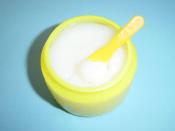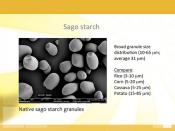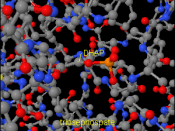INVESTIGATING THE EFFECT OF TEMPERATURE ON THE RATE OF ENZYME ACTIVITY.
To investigate the effect that temperature has on enzyme activity I am going to use the enzyme amylase, which is used as a biological catalyst to break down starch, which cannot pass through the gut wall due to the size of the molecules, into smaller ones. Amylase is a carbohydrase, which converts starch to simple sugars in the Salivary Glands. Three features of all enzymes are:
They are always proteins.
They are specific in their actions and each enzyme controls one particular type of action.
The enzymes are not changed in the reaction which they take part in, therefore they can be used over and over again.
Enzymes work by constantly moving around and colliding with substrates. There is one particular substrate for each enzyme. When it collides with the correct one, the substrate fits the depression, which is otherwise known, as the "active site."
The reaction then takes place and the products of reaction leave the active site. The whole process is repeated.
I predict that the enzymes will work at there fastest at around 37C. Both extracellular enzymes and intracellular enzymes are designed to work at body temperature, as they are biological catalysts and they are designed to speed up chemical reactions that take place in our body, inside and outside cells. This is the right temperature for the random movement of molecules, so that they collide as often as possible, without being destroyed. Without enzymes the reactions would be slow and we would not be able to live.
At 0C the enzymes will work slowly to break down the starch. At a lower temperature the enzymes will have little energy and this would make the constant movement extremely slow and therefore the substrate molecule, in this case starch, and the molecule of the right enzyme, amylase, will not collide as often therefore slowing down the process.
At 80C the enzymes will not work. The enzymes will not work at a high temperature as they are destroyed by heat. All enzymes are made out of proteins, this means that they are destroyed or deformed by heat. The starch would not fit into the active site of the amylase as the depressions on the surface have been destroyed/changed by the extreme temperatures. The substrate cannot "lock" in to the active site. Most enzymes are designed to work at a temperature of around 37C, although most of them can work up to 45C, before they are destroyed.
Apparatus.
APPARATUSUSE
Water BathsTo maintain the temperature that the enzymes are working at.
Specimen TubesTo place the solution of starch and amylase in.
Syringe (5ml and 2ml)To add the starch and amylase to the specimen tube
Spotting tilesTO see the progression of the effect of the amylase has had on the starch
PipetteFor accuracy when adding the solution to the iodine in the spotting tile
Stop ClockSo that solution can be added to iodine at regular time periods
Method.
Before the experiment begins, the water bath should be prepared at 0C, so that there is maximum accuracy in the experiment and to ensure that once the solution is placed in the water bath it as at the right temperature. Iodine should then be adding to the spotting tiles, so that at each 30 second interval the starch can immediately be placed onto the iodine. 2ml of starch is placed in the specimen tube. Next the specimen tube is placed in the iodine, so that once the amylase is added it can work at the correct temperature immediately, producing accurate results. 1ml of amylase is then added. The clock should be started as soon as the amylase is added and after the first 30 seconds, using the pipette a drop of the solution is added to the iodine in the spotting tray. The colour that the iodine changes to should be recorded. Keep recording the results every 30 seconds, until the iodine solution remains brown. The experiment should be repeated for accuracy and so that an average can be found. Repeat the whole experiment for water baths at temperatures of 20C, 40C, and 80C.
This method is an accurate way of carrying out this investigation as it keeps the time scale between each event (e.g. adding the amylase to the starch) to a minimum, whilst at the same time ensures that the amylase does not start working before it is supposed to, as well as using accurate methods (e.g. pipettes) to measure out the quantity of each substance neede.. There are many variables, which could change this experiment:
The ratio of starch to amylase in the specimen tube: This will be controlled, by using syringes, with the marked quantity on the side.
The temperature that the enzymes are working at: Throughout each experiment the temperatures will be kept the same, by leaving the specimen tubes in the water baths.
The amount of starch and amylase solution added to each spot of iodine: Two drops from the same pipette shall be added to each spot of iodine. Throughout all six tests these measurements shall be kept the same.
By using my experiment plan, I hope to obtain the most accurate results possible. The only variable which I hope to change is the temperature.
Analysing my results.
My results show that the optimum temperature for enzymes to work at is around 40C. These results fitted my predictions, as I expected this temperature to finish the reaction the fastest. The results for the other temperatures also fitted my predictions.
A line of best fit was more appropriate for my graph of results, as it gave a smooth curve. The graph shows that at 80C the enzymes did not work to break down the starch, this is because that enzymes were destroyed and therefore the "lock and key" theory could not work as the substrate could not fit into the active site. The higher temperatures deform the active sites as they are normally made out of proteins. This was the worst temperature for the enzymes to work at.
At 0C the enzymes worked, although fairly slowly, due to the fact that they lacked energy and therefore, did not collide with the substrates as often. This meant that the whole process of the amylase breaking down the starch into smaller molecules was slowed down and took a longer period of time than it would have done at the optimum temperature.
When the water baths were at a temperature of 20C and 40C, the enzymes worked at almost exactly the same rate and both reactions finished at 3 minutes and 30 seconds. This tells us that the optimum temperature for the enzymes to work at is located between these two temperatures, therefore making the optimum temperature close to body temperature. At 40C, the temperature was exactly right, so as not to deform the enzymes, but also to give them the maximum amount of energy, so that they are able to collide as often as possible with the right substrate, in this case starch, allowing the maximum possible of reactions to take place.
Evaluation.
I stuck to the method, which I had planned, and the results from using this method, were as accurate as possible. The results which we collected were as accurate as possible because to make it a fair test, we tried to keep each separate experiment the same and also used the minimum time in between each reading. This gave an accurate measure of the progression of the starch being broken down. All the results, which we collected, fitted the pattern, therefore our experiment worked well. The results could be counted on to be reliable as each experiment was carried out more than, giving averages. This also helps to be able to draw a conclusion from the results. As each result was done as accurately as possible I did not have to draw a line of best fits, as a smooth curve was produced on my graph giving a definite conclusion.
Collected enough results to be able to spot a pattern and match them to my prediction. If there was more time available, more temperatures could be used, which would give a greater degree of accuracy as well as ensuring that the enzymes worked in the same way up until the temperature which they are destroyed at. Other ways in which the experiment can be improved are:
Decreasing the time between each reading: This way the progression of the breaking down of the starch would be more clear and the time in which it took the reaction to finish would become more precise.
Increasing the amount of temperatures that the solution of starch and amylase were tested at:
This would allow the experiment to become more accurate and also the optimum temperature would become more accurate as well as the temperature at which the enzymes are destroyed.
Test each separate temperature more than twice: This is to prove that each temperature is affecting the enzymes the same way each time and that the previous result was not a fluke.
Although this investigation was accurate it only tells us about the affect that temperature has on amylase breaking down starch. Other experiments that could be carried out to extend this work and provide me with more evidence is:
The affect of concentration of the enzyme and starch. This would provide insight as to why some results may be inaccurate, due to different concentrations of each substance.
Changing the pH, at which the enzymes work at is useful, as enzymes work at different pHs within the body. This would help further the investigation as this variable inside the body is very important.
Using a different enzyme and substrate would also make the experiment more accurate as it would verify that these results do not just happen with amylase and starch, but also with other enzymes and substrates that also work in our bodies.


